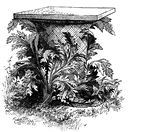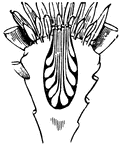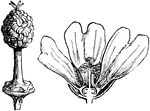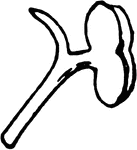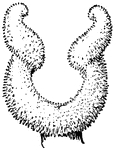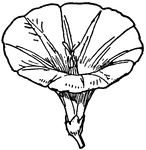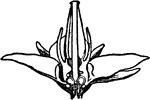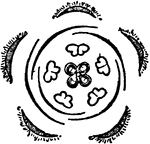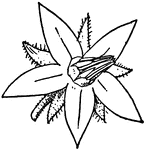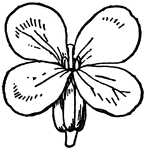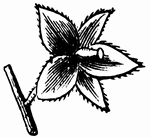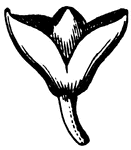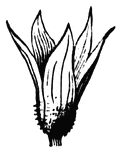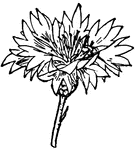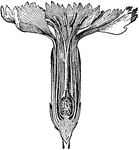The Flower Anatomy ClipArt gallery includes 418 illustrations of the parts of a flower.
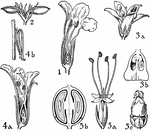
Orders of Acanthaceae, Myoporaceae, Phrymaceae, and Plantaginaceae
Pictured are flowers of the orders acanthaceae, myoporaceae, phrymaceae, and plantaginaceae. The flowers…
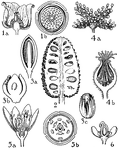
Annonaceae, Myristicaceae, Monimiaceae, and Lauraceae Orders
The orders of Annonaceae, Myristicaceae, Monimiaceae, and Lauraceae are pictured. The flowers of these…

Anther
"Image: Anther of Aquilegria. The essential polliniferous part of a stamen, generally raised upon the…

Anther
"Image: Anther of Aquilegria, expanded. The essential polliniferous part of a stamen, generally raised…

Anther
"Image: Anther of Lilium. The essential polliniferous part of a stamen, generally raised upon the extremity…
Anther
"Image: Anther of Berberis. The essential polliniferous part of a stamen, generally raised upon the…
Anther
"Image: Anther of Solanum. The essential polliniferous part of a stamen, generally raised upon the extremity…

Anther
"Image: Anther of Ecbalium. The essential polliniferous part of a stamen, generally raised upon the…

Anther
Diagram of the lower part of an anther, cut across above, and the upper part of a leaf, to show how…
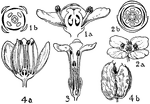
Orders of Aquifoliaceae, Celastraceae, Stackhousiaceae, and Staphyleaceae
The orders pictured are aquifoliaceae, celastraceae, stackhousiaceae, and staphyleaceae. The flowers…
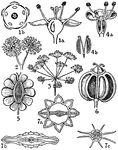
Orders of Araliaceae and Umbelliferae
Pictured are flowers of the orders araliaceae and umbelliferae. The flowers of these orders that are…

Aretia
"1. Aretia Vitaliana; 2. a flower cut open; 3. the pistil; 4. a vertical section of the latter, showing…
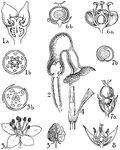
Aristolochiaceae, Polygonaceae, Chenopodiaceae, and Amarantaceae Orders
Shown are the Aristolochiaceae, Polygonaceae, Chenopodiaceae, and Amarantaceae orders. Also illustrated…
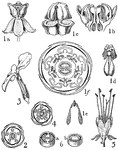
Orders of Asclepiadaceae, Convolvulaceae, Polemoniaceae, and Hydrophyllaceae
Pictured are flowers of the orders asclepiadaceae, convolvulaceae, polemoniaceae, and hydrophyllaceae.…
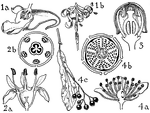
Orders of Balsaminaceae, Rhamnaceae, Vitaceae, and Tiliaceae
The orders pictured are balsaminaceae, rhamnaceae, vitaceae, and tiliaceae. The flowers of these orders…
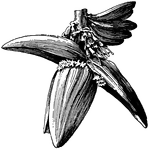
Flower Cluster of Banana
Illustrated in the tip of a flower cluster of banana. The cluster is similar to a giant, elongated bud…
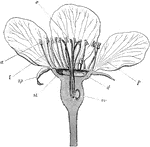
Bartlett Pear Flower
"Enlarged section of a Bartlett pear flower: st, style; sp, sepal; f, filament; a, anther; s, stigma;…
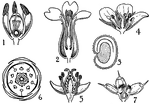
Bassellaceae and Caryophyllaceae Order
Pictured are the orders of Bassellaceae and Caryophyllaceae. The flower pictured belong to the Bassellaceae…

Berberidaceae, Menispermaceae, Mahnoliaceae, and Calycanthaceae Orders
Shown are the orders of berberidaceae, menispermaceae, magnoliaceae, and calycanthaceae. The illustrated…
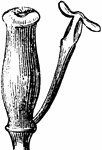
Pistil and Stamen of Burberis
An illustration of the a stamen and pistil of the berberis plant. Berberis (Bér-be-ris, barberry,…

Borage Gynoecium
"Gynobase. Section of Gynoecium of Borage, gynobase (a) bearing the carpels and style." -Whitney, 1911
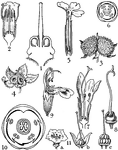
Orders of Boraginaceae, Verbenaceae, Labiatae, and Nolanaceae
Pictured are flowers of the order boraginaceae, verbenaceae, labiatae, and nolanaceae. The flowers of…
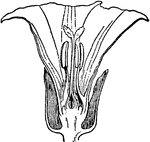
Calystegia Sepium
Calystegia sepium (Larger Bindweed, Hedge Bindweed, or Rutland beauty) is a species of bindweed, with…
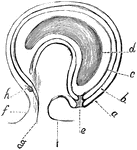
Campylotropous Ovule in Section
The campylotropous ovule is curved. Pictured are two coats of the campylotropous ovule.

Cannaceae, Marantaceae, and Orchidaceae Orders
Pictured are the orders of Cannaceae, Marantaceae, and Orchidaceae. Illustrated are various flowers…
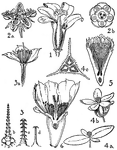
Orders of Caricaceae, Loasceae, Begoniaceae, and Cactaceae
Represented are the orders of caricaceae, loasaceae, begoniaceae, and cactaceae. The flowers of these…
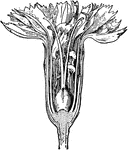
Carnation Section
The section of carnation shows the leaf anthers. One is in the process of doubling.
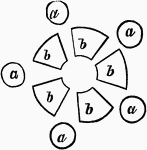
Arrangement of Stamens and Carpels
"If in Fig. 132, a, a, a, a, a, represent five stamens, and b, b, as many carpels, it will be observed…
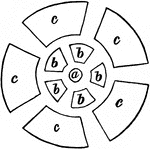
Two Whorls of Carpels
"When the carpels consist of several whorls on the same plane, the individuals of contiguous whorls…
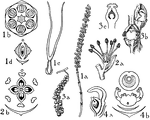
Casuarinaceae, Saururaceaem, Oiperaceae, and Chloranthaceae Orders
Shown are the orders of Casuarinaceae, Saururaceaem, Oiperaceae, and Chloranthaceae. Pictured are various…
